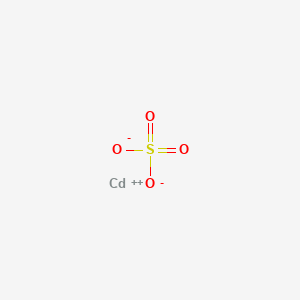

1. Cadmium Sulfate, Hydrate (3:8)
2. Cadmium Sulfate, Tetrahydrate
1. 10124-36-4
2. Cadmium Sulphate
3. Sulfuric Acid, Cadmium Salt (1:1)
4. Cadmium Monosulfate
5. Cadmium Sulfate (1:1)
6. Cadmium(2+) Sulfate
7. Cadmium Sulphate (1:1)
8. Cadmium(2+);sulfate
9. Cdso4
10. 947unf3z6o
11. 13477-20-8
12. Cadmium Sulfuricum
13. Sulfuric Acid, Cadmium Salt (1:1), Monohydrate
14. Cadmium Sulfate, Tetrahydrate
15. Caswell No. 136c
16. Sulfate De Cadmium
17. Ccris 116
18. Hsdb 274
19. Einecs 233-331-6
20. Cadmium Sulfate Monohydrate
21. Sulphuric Acid, Cadmium Salt (1:1)
22. Epa Pesticide Chemical Code 012905
23. Unii-947unf3z6o
24. Cadmiumsulfat
25. Kadmiumsulfat
26. Sulfuric Acid, Cadmium Salt, Tetrahydrate
27. Cadmium Mesosulfate (cdh2so5)
28. Cadmium Sulfate, Hydrate
29. Sulfato De Cadmio
30. Cadmium Sulphuricum
31. Cadmium Sulfate, Anhydrous
32. Ec 233-331-6
33. Cadmium Sulfate [cadmium And Cadmium Compounds]
34. Cadmium Sulfate [mi]
35. Cadmium Sulfate [hsdb]
36. Cadmium Sulfate [mart.]
37. Dtxsid1020229
38. Chebi:50292
39. Cadmium Sulfate [who-dd]
40. Cadmium Sulphuricum [hpus]
41. Mfcd00010923
42. Akos015915940
43. 13477-21-9
44. Cadmium Sulfate, Acs Reagent, >=99.0%
45. Db-023000
46. Cadmium Sulfate, >=99.99% Trace Metals Basis
47. Q414806
| Molecular Weight | 208.48 g/mol |
|---|---|
| Molecular Formula | CdO4S |
| Hydrogen Bond Donor Count | 0 |
| Hydrogen Bond Acceptor Count | 4 |
| Rotatable Bond Count | 0 |
| Exact Mass | 209.855095 g/mol |
| Monoisotopic Mass | 209.855095 g/mol |
| Topological Polar Surface Area | 88.6 Ų |
| Heavy Atom Count | 6 |
| Formal Charge | 0 |
| Complexity | 62.2 |
| Isotope Atom Count | 0 |
| Defined Atom Stereocenter Count | 0 |
| Undefined Atom Stereocenter Count | 0 |
| Defined Bond Stereocenter Count | 0 |
| Undefined Bond Stereocenter Count | 0 |
| Covalently Bonded Unit Count | 2 |
IN RABBITS GIVEN 60 DAILY SC INJECTIONS OF CADMIUM SULFATE, ONLY ABOUT 1% OF DOSE WAS EXCRETED IN URINE EACH DAY.
IARC. Monographs on the Evaluation of the Carcinogenic Risk of Chemicals to Humans. Geneva: World Health Organization, International Agency for Research on Cancer, 1972-PRESENT. (Multivolume work). Available at: https://monographs.iarc.fr/ENG/Classification/index.php, p. V11 60 (1976)
ABOUT 20% OF IV DOSE IN RATS WAS EXCRETED VIA FECES IN 72 HR & LITTLE ... (115)CADMIUM WAS FOUND IN URINE; DISTRIBUTION IN LIVER ... AS SULFATE WAS UNIFORM, WHEREAS IN KIDNEY THE CORTEX SHOWED HIGH ACCUM & MEDULLA CONTENT WAS LOW. PANCREAS ACCUMULATED LARGE AMT IN UNIFORM DISTRIBUTION.
Patty, F. (ed.). Industrial Hygiene and Toxicology: Volume II: Toxicology. 2nd ed. New York: Interscience Publishers, 1963., p. 1014
NEARLY 70% OF (109)CD-LABELED CADMIUM SULFATE WAS FOUND IN LIVER 20 DAYS AFTER IP ADMIN TO RATS. WHEN ADMIN SMALL REPEATED DAILY DOSES, LIVER ACCUM, RATHER THAN RENEW, ITS CADMIUM SUPPLY. BILE WAS ACTUALLY INSTRUMENTAL IN REABSORPTION OF CADMIUM INTO INTESTINE.
CAUJOLLE F ET AL; J EUR TOXICOL 3 (4): 310 (1971)
WHETHER CADMIUM SULFATE WAS INJECTED SC, IP OR IM TO RATS, THE AMT OF CADMIUM EXCRETED INTO URINE WERE NEARLY SAME.
FURST A ET AL; PROC WEST PHARMACOL SOC 15: 55 (1972)
Copper and cadmium uptake and distribution in 2-week-old seedlings of stone pine (Pinus pinea L.), maritime pine (Pinus pinaster Ait.) and ash (Fraxinus angustifolia Vahl.) were investigated. Seedlings were grown in culture solution at increasing concentrations of CuSO4, (0.012-5 muM) and CdSO4 (0.0-5 muM). All species accumulated copper in a larger amount than cadmium. Translocation to the shoot was strongly restricted for both metals, though higher cadmium mobility within the plant could be evidenced. A strong relationship between root content and growth inhibition was detected in the roots in response to copper but not to cadmium treatments. Among species P. pinea seemed to be more tolerant to cadmium, whereas F. angustifolia was highly sensitive to both cadmium and copper. X-ray microanalysis of root tip sections showed that copper and cadmium only accumulated in the root tips of F. angustifolia, copper mostly in the cell walls of the cortex layer, cadmium in the inner compartments of the cortex cells. It is suggested that in the two Pinus species the well developed root cap plays a protecting role against metal uptake at the root-tip zone.
Arduini I et al; Physiologia Plantarum 97 (1): 111-7 (1996)